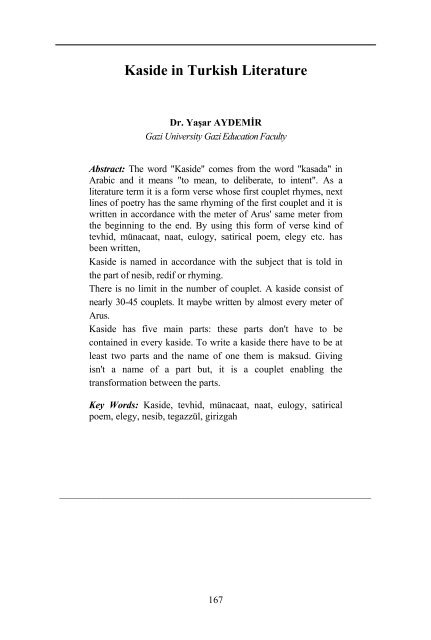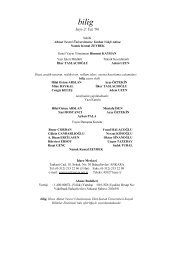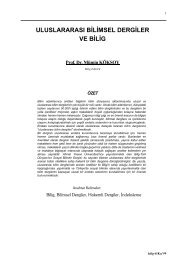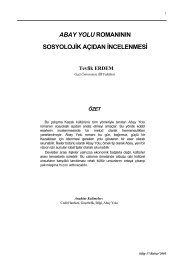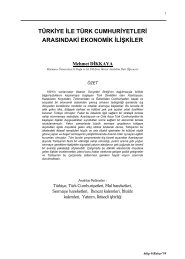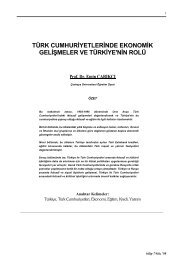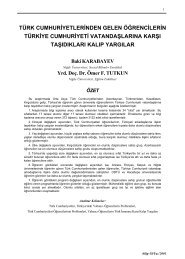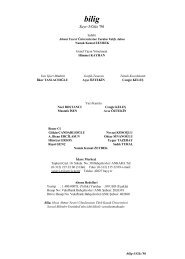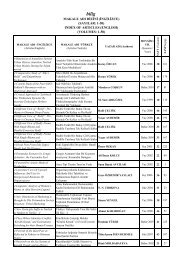ilig 2002 Yaz Sayı 22 RÂMÎ, Dîvân, Milli Kütüphane, MFA (D) 606 RÂSİH, Dîvân, Milli Kütüphane, Yz. FB.252/1 RESMÎ, Dîvân, Süleymaniye Kütüphanesi, Haşim Paşa, 85/1 RUHÎ-i Bağdâdî (1287), Külliyât-ı Eş'âr. SABİR, Dîvân, Süleymaniye Kütüphanesi, Raşid Efendi, 765/1 SUNGUR, Necâti (1990), Âhî Divanı, İnceleme-Metin, Gazi Üni. S:B:E., Yayınlanmamış Y.Lisans tezi, Ankara. ŞEREF Hanım, Divan, İstanbul 1284 ŞERÎF, Dîvân, Süleymaniye Kütüphanesi, Esad Efendi, 3442/5. ŞEYH Rızâ, Dîvan, MFA. (A). 3233. ŞİNÂSÎ, Dîvân, Süleymaniye Kütüphanesi, Esad Efendi, 2648. TÂLİB, Dîvân, Milli Kütüphane, Yz. FB. 191. TANPINAR, A. Hamdi (1985), XIX. Asır Türk Edebiyatı Tarihi VI. Baskı, İstanbul. TARLAN, Ali Nihat (1945), Hayâlî Bey Divanı, İstanbul TECELLÎ, Dîvân, Milli Kütüphane, MFA (D)1008. TİMURTAŞ, E Kadri (1963), Şeytâ'nın Hüsrev ü Şîrîn'i, İstanbul. TULUM, Mertol - TANYERİ, M. Ali (1977), Nev'i Yahyâ Divan, İstanbul ÜSKÜDARLI Sırrı, Dîvân, Milli Kütüphane, MFA (D) 1081 ÜSTAD CELÂL Hümâyî (T.y.), Fünûn-ı Belâgât ve Sınâ'ât-ı Edebî, Tahran ÜZGÖR, Tahir (1991), Fehîm-i Kadîm, Hayatı, Sanatı, Dîvânı ve Metnin Bugünkü Türkçesi, A.K.D.T.Y.K., Ankara. VA'DÎ, Dîvân, Milli Kütüphane, MFA (A) 397. VEYSÎ, Dîvân, Milli Kütüphane, MFA (A) 4281. YATMAN, Mustafa (1989), Osmanzâde Tâib Divanından Seçmeler, Kültür Bak. Yay. Ankara. YILMAZ, Kaşif (1984), Güftî Ati, Hayatı, Eserleri, Edebî Kişiliği, Dîvânı ve Teşru'fâtü'ş-Şu''arası''nın Tenkidli Metni, Doktora Tezi, A.Ü., Erzurum. YÜSRÎ, Dîvân, Süleymaniye Kütüphanesi, İzmir, 532/1 ZUHÛRÎ, Dîvân, Milli Kütüphane, MFA (D) 854 166
Kaside in Turkish Literature Dr. Yaşar AYDEMİR Gazi University Gazi Education Faculty Abstract: The word "Kaside" comes from the word "kasada" in Arabic and it means "to mean, to deliberate, to intent". As a literature term it is a form verse whose first couplet rhymes, next lines of poetry has the same rhyming of the first couplet and it is written in accordance with the meter of Arus' same meter from the beginning to the end. By using this form of verse kind of tevhid, münacaat, naat, eulogy, satirical poem, elegy etc. has been written, Kaside is named in accordance with the subject that is told in the part of nesib, redif or rhyming. There is no limit in the number of couplet. A kaside consist of nearly 30-45 couplets. It maybe written by almost every meter of Arus. Kaside has five main parts: these parts don't have to be contained in every kaside. To write a kaside there have to be at least two parts and the name of one them is maksud. Giving isn't a name of a part but, it is a couplet enabling the transformation between the parts. Key Words: Kaside, tevhid, münacaat, naat, eulogy, satirical poem, elegy, nesib, tegazzül, girizgah _______________________________________________________________ 167
- Page 1 and 2:
Asya Tipi Üretim Tarzı'na Veda Ya
- Page 3 and 4:
Başak Avcılar, Asya Tipi Üretim
- Page 5 and 6:
Başak Avcılar, Asya Tipi Üretim
- Page 7 and 8:
Başak Avcılar, Asya Tipi Üretim
- Page 9 and 10:
Başak Avcılar, Asya Tipi Üretim
- Page 11 and 12:
Başak Avcılar, Asya Tipi Üretim
- Page 13 and 14:
Başak Avcılar, Asya Tipi Üretim
- Page 15 and 16:
Başak Avcılar, Asya Tipi Üretim
- Page 17 and 18:
Başak Avcılar, Asya Tipi Üretim
- Page 19 and 20:
Başak Avcılar, Asya Tipi Üretim
- Page 21 and 22:
Başak Avcılar, Asya Tipi Üretim
- Page 23 and 24:
Başak Avcılar, Asya Tipi Üretim
- Page 25 and 26:
Başak Avcılar, Asya Tipi Üretim
- Page 27 and 28:
A Farewell to Asiatic Mode of Produ
- Page 29 and 30:
Yerel Kalkınma Stratejisi İçinde
- Page 31 and 32:
Gürbüz, Yerel Kalkınma Stratejis
- Page 33 and 34:
Gürbüz, Yerel Kalkınma Stratejis
- Page 35 and 36:
Gürbüz, Yerel Kalkınma Stratejis
- Page 37 and 38:
Gürbüz, Yerel Kalkınma Stratejis
- Page 39 and 40:
Gürbüz, Yerel Kalkınma Stratejis
- Page 41 and 42:
Gürbüz, Yerel Kalkınma Stratejis
- Page 43 and 44:
Gürbüz, Yerel Kalkınma Stratejis
- Page 45 and 46:
Gürbüz, Yerel Kalkınma Stratejis
- Page 47 and 48:
Tourism and Safranbolu Model in the
- Page 49 and 50:
Tarih ve Tarihî Roman Arasındaki
- Page 51 and 52:
Çelik, Tarih ve Tarihi Roman Aras
- Page 53 and 54:
Çelik, Tarih ve Tarihi Roman Aras
- Page 55 and 56:
Çelik, Tarih ve Tarihi Roman Aras
- Page 57 and 58:
Çelik, Tarih ve Tarihi Roman Aras
- Page 59 and 60:
Çelik, Tarih ve Tarihi Roman Aras
- Page 61 and 62:
Çelik, Tarih ve Tarihi Roman Aras
- Page 63 and 64:
Çelik, Tarih ve Tarihi Roman Aras
- Page 65 and 66:
Çelik, Tarih ve Tarihi Roman Aras
- Page 67:
___________________________________
- Page 70 and 71:
ilig 2002 Yaz Sayı 22 bir tema ola
- Page 72 and 73:
ilig 2002 Yaz Sayı 22 Taşçaynar
- Page 74 and 75:
ilig 2002 Yaz Sayı 22 Yazar, Filof
- Page 76 and 77:
ilig 2002 Yaz Sayı 22 b. Sovyetler
- Page 78 and 79:
ilig 2002 Yaz Sayı 22 korku komple
- Page 80 and 81:
ilig 2002 Yaz Sayı 22 Aytmatov, bu
- Page 82 and 83:
ilig 2002 Yaz Sayı 22 Bir kudret-i
- Page 84 and 85:
ilig 2002 Yaz Sayı 22 ERHAT, Azra,
- Page 86 and 87:
___________________________________
- Page 88 and 89:
ilig 2002 Yaz Sayı 22 de "ithaftı
- Page 90 and 91:
ilig 2002 Yaz Sayı 22 "Ey, vatanı
- Page 92 and 93:
ilig 2002 Yaz Sayı 22 yim. Tâhir
- Page 94 and 95:
ilig 2002 Yaz Sayı 22 nin bütün
- Page 96 and 97:
ilig 2002 Yaz Sayı 22 Bu ithaflard
- Page 98 and 99:
ilig 2002 Yaz Sayı 22 Haşim'in sa
- Page 100 and 101:
ilig 2002 Yaz Sayı 22 nûn mektebi
- Page 102 and 103:
ilig 2002 Yaz Sayı 22 8 Sanat anla
- Page 104 and 105:
Kaynaklar bilig 2002 Yaz Sayı 22 A
- Page 106 and 107:
Analysis of the Term "Dedication" i
- Page 109 and 110:
Eleştiri Terimleri Açısından He
- Page 111 and 112:
Çetindağ, Eleştiri Terimleri Aç
- Page 113 and 114:
Çetindağ, Eleştiri Terimleri Aç
- Page 115 and 116: Çetindağ, Eleştiri Terimleri Aç
- Page 117 and 118: Latîf Çetindağ, Eleştiri Teriml
- Page 119 and 120: Çetindağ, Eleştiri Terimleri Aç
- Page 121 and 122: Çetindağ, Eleştiri Terimleri Aç
- Page 123 and 124: Çetindağ, Eleştiri Terimleri Aç
- Page 125 and 126: Çetindağ, Eleştiri Terimleri Aç
- Page 127 and 128: Çetindağ, Eleştiri Terimleri Aç
- Page 129 and 130: Çetindağ, Eleştiri Terimleri Aç
- Page 131 and 132: The Influence of the Herat School T
- Page 133 and 134: Türk Edebiyatında Kaside Dr. Yaş
- Page 135 and 136: Aydemir, Türk Edebiyatında Kaside
- Page 137 and 138: Aydemir, Türk Edebiyatında Kaside
- Page 139 and 140: Aydemir, Türk Edebiyatında Kaside
- Page 141 and 142: Aydemir, Türk Edebiyatında Kaside
- Page 143 and 144: Aydemir, Türk Edebiyatında Kaside
- Page 145 and 146: Aydemir, Türk Edebiyatında Kaside
- Page 147 and 148: Aydemir, Türk Edebiyatında Kaside
- Page 149 and 150: Aydemir, Türk Edebiyatında Kaside
- Page 151 and 152: Aydemir, Türk Edebiyatında Kaside
- Page 153 and 154: Aydemir, Türk Edebiyatında Kaside
- Page 155 and 156: Aydemir, Türk Edebiyatında Kaside
- Page 157 and 158: Aydemir, Türk Edebiyatında Kaside
- Page 159 and 160: Aydemir, Türk Edebiyatında Kaside
- Page 161 and 162: Aydemir, Türk Edebiyatında Kaside
- Page 163 and 164: Aydemir, Türk Edebiyatında Kaside
- Page 165: Aydemir, Türk Edebiyatında Kaside
- Page 169 and 170: Ümumtürk Edabiyyatı Araşdırıc
- Page 171 and 172: Hüseynoğlu, Ümumtürk Edabiyyat
- Page 173 and 174: Hüseynoğlu, Ümumtürk Edabiyyat
- Page 175 and 176: Hüseynoğlu, Ümumtürk Edabiyyat
- Page 177 and 178: Hüseynoğlu, Ümumtürk Edabiyyat
- Page 179 and 180: Hüseynoğlu, Ümumtürk Edabiyyat
- Page 181 and 182: Hüseynoğlu, Ümumtürk Edabiyyat
- Page 183: 183
- Page 186 and 187: ilig 2002 Yaz Sayı 22 Bir zamanlar
- Page 188 and 189: ilig 2002 Yaz Sayı 22 lerini ele a
- Page 190 and 191: ilig 2002 Yaz Sayı 22 "Türkmenced
- Page 192 and 193: ilig 2002 Yaz Sayı 22 PARLATIR, İ
- Page 194 and 195: ilig 2002 Yaz Sayı 22 ma amacı ta
- Page 196 and 197: ilig 2002 Kış Sayı 20 si bulundu
- Page 198 and 199: ilig 2002 Kış Sayı 20 molojiyle
- Page 200 and 201: ilig 2002 Kış Sayı 20 LÂM'Î Ç
- Page 202 and 203: ilig 2002 Kış Sayı 20 bir çalı
- Page 204 and 205: ilig 2002 Kış Sayı 20 çeviri ya
- Page 206 and 207: Bilig’de yayımlanması kabul edi
- Page 208 and 209: Kaynaklar Dizini a) Süreli yayınl
- Page 210 and 211: Payments to the authors and referee
- Page 212: c. For books The name(s) of author(


